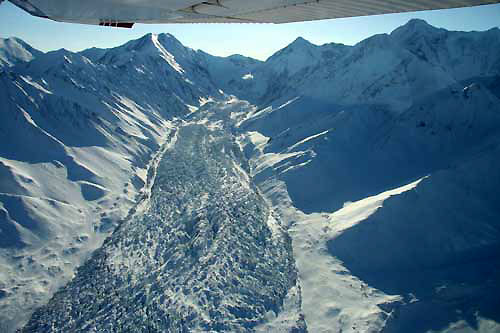 by Ned Rozell March 17, 2006
With its violent winter transformation, McGinnis Glacier becomes the latest of several glaciers in the Alaska Range that get up and go after long periods of sloth. Ice experts call these "surging" glaciers. Surging glaciers build up snow and ice in their upper portions for years until all that weight flows downhill in dramatic fashion. Surging glaciers aren't necessarily growing glaciers; when a glacier surges, ice mass that was at high elevations moves to lower elevations, making a mess of the glacier in the process.  Photo by Dana Moudra-Truffer.
Truffer saw the telltale sign that McGinnis Glacier had surged-a severely crevassed surface and a face of ice 300 feet-high-while on a recent attempt to drive snowmachines into nearby Black Rapids Glacier. After giving up on getting into Black Rapids with his guides Mike Reitz and Dick Flaharty, they snowmachined farther north because Truffer wanted to see the great rockslides that fell from McGinnis Peak during the Denali Fault earthquake of November 2002. When they approached the lobes of the glacier that wrap around the 11,400-foot peak, Truffer noticed the rough surface of the glacier and wondered what he was seeing. "When I first saw it, I didn't get it," he said. "I wondered if what I saw was the rockfall, but from far away it looked really rough. When we got closer, I said 'No, this is a glacier surge. It was totally unexpected, which is what makes it really cool." A pilot, Truffer flew down from Fairbanks a day later with his wife Dana and fellow glaciologist Will Harrison. From above, Harrison and Truffer decided that the glacier had surged during winter 2005-2006 because ice pinnacles at the glaciers face were sharp, showing no signs of summer melting. Surging glaciers move in the wintertime, when just enough water flows at the base of the glacier to lift it up and allow gravity to move great masses of ice from higher to lower elevations. Glaciers don't surge in summer because so much water flows beneath glaciers that it blows out the delicate plumbing system required to float a glacier, Truffer said. "In summer, there's so much water that it all drains out and no longer lifts," Truffer said. "The surge stops dead in its tracks." Glaciologists once thought that great earthquakes were the cause of surging glaciers, and McGinnis, Black Rapids, Yanert, and other surging glaciers of the Alaska Range all sit very close to the Denali Fault, where a magnitude 7.9 earthquake ripped the ice surface along glaciers for hundreds of miles in 2002. But scientists didn't notice any glaciers surging after that big earthquake, and they think what's beneath a glacier determines whether it surges. "We think there's geological controls; the glaciers near the Denali Fault are usually on crappy bedrock with lots of till and sedimentation," Truffer said, adding that water is also a vital ingredient for a surging glacier. A few days after flying over the glacier that he can almost see from his fourth-story office window in Fairbanks, Truffer marveled at how this large, violent, event happened during the quiet of winter with probably no human witnesses. "Where else in the world can you have a glacier go totally nuts and nobody sees it?" Alaska Fairbanks, in cooperation with the UAF research community. Ned Rozell [nrozell@gi.alaska.edu]is a science writer at the institute. Publish A Letter on SitNews Read Letters/Opinions
|